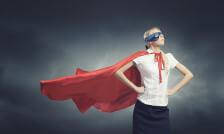How Power Poses Can Build Confidence
Are you looking for a simple technique to help you be a more captivating and confident presenter? The Public Speaker explains how holding a power pose for just a few minutes can change how others view you and how you view yourself.
Lisa B. Marshall
Listen
How Power Poses Can Build Confidence

I’m talking about the art of power posing. By now, you may have seen Harvard Business School Professor, Amy Cuddy’s TedTalk “Your Body Language Shapes Who You Are.” In it, Cuddy’s message is simple:
Power posing for 2 minutes will change how others perceive you and how you perceive yourself.
Professor Cuddy discusses two different kinds of power poses, high power and low power. Her research shows that just two minutes of high power posing results in a 20% increase in testosterone and a 20% decrease in cortisol. Low power poses, on the other hand, produce the opposite effect.
But what are high power and low power poses? Let’s find out.
High Power Poses
High power poses exude power and confidence. The most common high power poses are:
-
Tall and Proud: Lift up your arms in a V shape and elevate your chin. Hold the pose.
-
Wonder Woman: Put your hands powerfully on your hips, spread your legs wide, and shift your pose to make yourself feel bigger.
Other high power postures include:
-
Spreading your arms and body across two chairs. When you take up more space, you exhibit confidence.
-
Hands behind your head, leaning back in your chair.
-
Sitting with your hands behind your head and feet on the table.
Low Power Poses
Low power poses make you feel less confident. They exhibit insecurity and the need to protect yourself. They include:
-
Putting your hands on your face or neck, as if protecting yourself from others.
-
Slumping your shoulders forward with your hands in your pockets.
-
Sitting, your hands between your legs, looking down.
-
Hunched over with fists clenched.
Interestingly, arm crossing can be a high power pose or a low power pose. Crossing your arms with your shoulders low and forward is a low power pose, but crossing your arms with your shoulders back and head held high is a high power pose.
You can read all the details of Professor Cuddy’s research in “The Benefit of Power Posing before a High Stakes Social Evaluation.”
Using Power Poses to Benefit You
How can you use this research to appear more confident and captivating when presenting?
Instead of sitting, hunched over your phone or notes during the minutes leading up to your speech, go someplace private—like a bathroom stall or a conference room—and hold a power pose for 2 minutes. It may seem a bit awkward at first, but I promise, you will feel more confident and more engaging.
See also: 6 Tips to Calm Your Nerves Before Speaking
One word of caution—some power postures don’t translate well across cultures. A study done at The University of Buffalo showed that expansive hands spread on a desk and upright sitting poses had universal benefits. However, the feet on the desk pose did not lead East Asians to feel more powerful.
I know this stuff can sometimes sound silly, but don’t knock it until you’ve tried it! It really works. In fact, it’s a great skill to teach your kids. I suggest practicing different postures at home to feel the effects of them and whether they lead you to feel more confident and powerful.
This is Lisa B. Marshall, helping you maximize sales, manage perceptions, and enhance leadership through keynotes, workshops, books, and online courses. Passionate about communication; your success is my business.
If you want even more success in your life, I invite you to read my latest book, Smart Talk and listen to my other podcast, Smart Talk: Inspiring Conversations with Exceptional People.
Young, Confident Woman and Relaxed Businessman images via Shutterstock.

